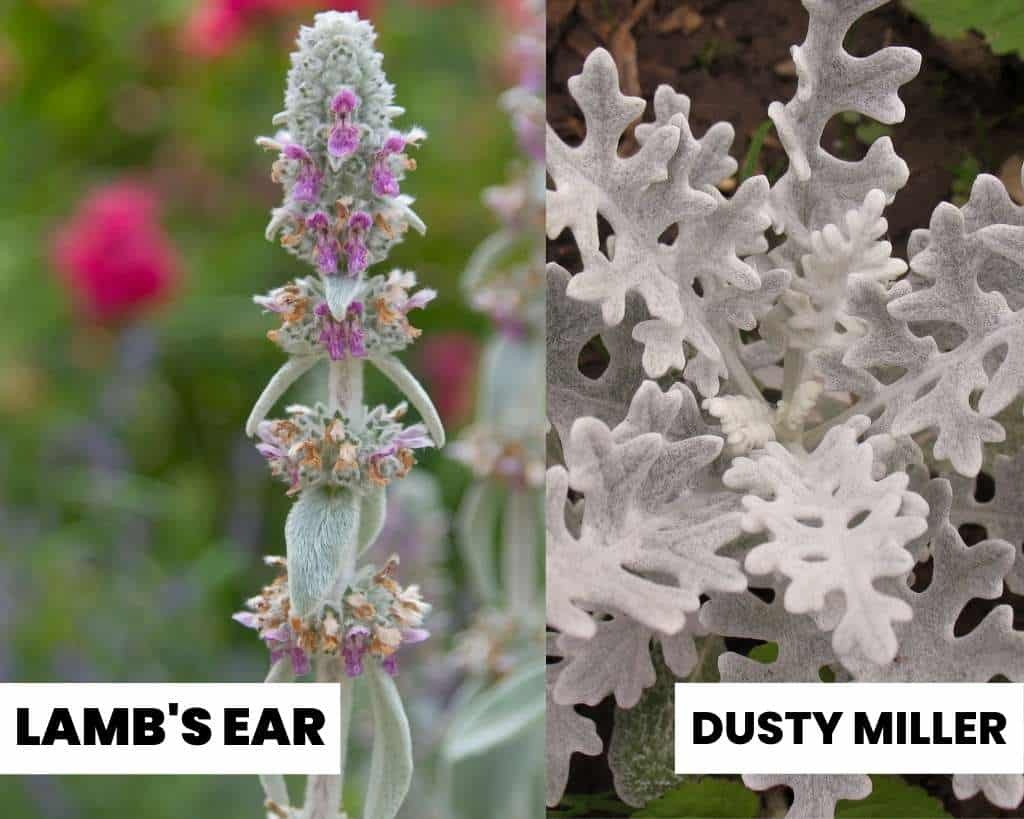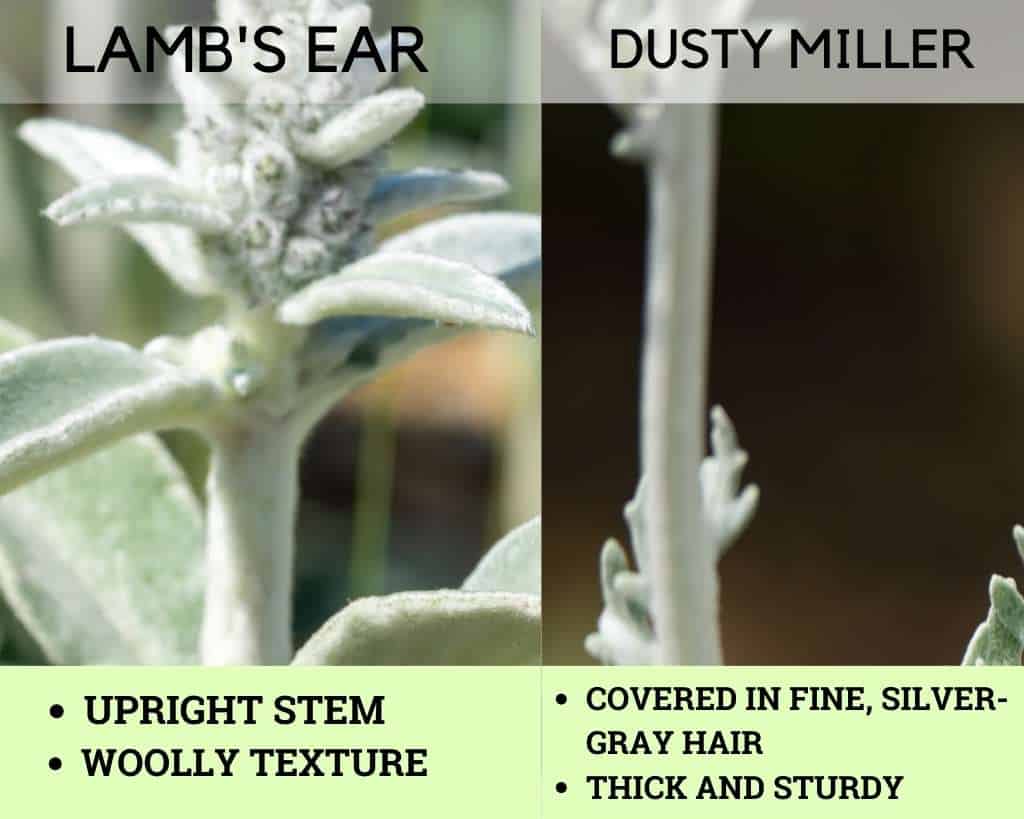If we are talking about creating a visual appealing garden that looks beautiful all year round, it is important to incorporate Lamb’s Ear and Dusty Miller into the discussion. These silver colored plants amplify the garden when planted with lavender, petunias and nigellas.
When comparing “lamb’s ear vs dusty miller”, one key difference is that lamb’s ear is a perennial plant and will come back year after year, while dusty miller is an annual and will need to be replanted each year.
In this blog, we will be comparing Lamb’s Ear vs Dusty Miller, discussing their similarities and differences, and helping you to decide which plant will work best in your garden.
| Lamb’s Ear | Dusty Miller | |
| Name | Stachys byzantina | Senecio cineraria |
| Zones | 4-9 | 8-11 |
| Height | 1-2 feet | 1-2 feet |
| Width | 1-2 feet | 1-2 feet |
| Sunlight | Full sun to partial shade | Full sun to partial shade |
| Soil | Well-Drained | Well-Drained |
| Lifespan | Perennial | Annual or short-lived perennial |
| Origin | Middle-East | Mediterranean region |
| Family | Lamiaceae | Asteraceae |
| Propagation | Seeds, Division | Seeds, Cuttings |
| Diseases | powdery mildew and rust | powdery mildew and rust |
| Pests | slugs and snails | aphids and spider mites |
Lamb’s Ear vs Dusty Miller – Key Differences & Similarities

Now, we will delve into the topic of “Lamb’s Ear vs Dusty Miller” and examine all of the key attributes of these two plants to provide a comprehensive understanding of their similarities and differences.
Plant Size
One fundamental similarity between these perennial, ground-cover plants is their height. Both plants are approximately 1-2 feet tall. Lamb’s Ear is a low-growing plant and tends to have a spreading habit. The width of the Lamb’s Ear plant is 1-2 feet.
Dusty Miller is a slow-growing plant and tends to have a mounded or cushion-like shape. The width of the Dusty Miller plant is 1-2 feet.
Stems

Lamb’s Ear stem is generally short and unbranched. It is covered in fine hair, giving them a soft, fuzzy texture.
The stem of Dusty Miller is woody at the base and becomes herbaceous towards the top; it tends to be taller and thinner than Lamb’s Ear’s stem and has a more upright growth habit.
Leaves – color, shape, size, and texture

The curve-shaped leaves of Lamb’s Ear are covered with fine hair that gives them a fuzzy texture. The leaves are 2-4 inches long. They are arranged in a rosette pattern around the base of the plant.
Dusty Miller’s silver-gray foliage is similar to Lamb’s Ear. The leaves are typically lobed or deeply cut and can grow to be 2-4 inches long. They are arranged alternately along the stem of the plant.
Flowers

Unlike the leaves of Lamb’s Ear, the tiny, pink or purple colored flowers of Lamb’s Ear are not showy and attractive. Flowers of Lamb’s Ear appear at the top of tall spikes that grow above the leaves. These small, tubular-shaped flowers are arranged in clusters.
The small yellow flowers of Dusty Miller resemble the flowers of a daisy; they are small and simple, with a yellow central disk and yellow-ray florets around the edge. These are arranged in clusters at the tips of the stems.
Growing Conditions
Soil
When considering Lamb’s Ear vs Dusty Miller, both the plants prefer well-drained soils rich in organic matter, slightly alkaline pH, and tolerant to a wide range of soil types, but Dusty Miller likes a somewhat higher pH range than Lamb’s Ear.
Light
Lamb’s Ear and dusty miller prefer full sun or at least 6 hours of direct sunlight per day. However, they will not grow as vigorously in partial shade.
Temperature and Humidity
Both plants thrive in hotter climatic conditions, which makes them ideal for xeriscape gardens. Lamb’s Ear can survive harsh colder conditions when compared to Dusty Miller.
Watering and irrigation
Both Lamb’s Ear and Dusty Miller prefer moderate watering. They can tolerate drought conditions and should be watered deeply and infrequently, allowing the soil to dry out slightly before watering again. To avoid root rot, err on the side of under-watering.
Fertilization and Nutrients
Both plants are easy to grow and don’t require extensive care to thrive. Occasional fertilization with a well-balanced fertilizer will get the best out of both plants. If you plan to grow them, make sure to fertilize both plants during the spring before they start to grow.
Pest and Disease Management
Lamb’s Ear and Dusty Miller are susceptible to several diseases and pests. Common fungal diseases that affect these plants include powdery mildew and rust. Powdery mildew is a white or grayish-white powdery growth on the leaves of infected plants. Rust appears as orange or reddish spots on the leaves of Lamb’s Ear and Dusty Miller, while leaf spot causes yellowing or brown spots on the leaves.
In addition to fungal diseases, Lamb’s Ear and Dusty Miller are also vulnerable to several insect pests, including aphids, mealybugs, spider mites, and thrips. Aphids feed on the sap of these plants, causing distorted growth in new growth areas. Mealybugs can cause wilting of the foliage due to their feeding habits. Spider mites mostly damage the underside of the foliage causing discoloration.
Propagation and Spacing
Lamb’s Ear and Dusty Miller can be propagated by division, stem cuttings, seed or dividing the roots and do well in well-drained soil. They should be spaced about 12-18 inches apart to allow enough room for the plants to spread.
Care and Maintenance
As discussed earlier in this article, both plants require minimal care and maintenance to grow well. They are drought-tolerant and can tolerate various soil types, including sandy or clay.
During the growing season, they should be watered regularly and fertilized every four to six weeks with a balanced, water-soluble fertilizer. To maintain a tidy appearance, it is best to trim the leaves back in the fall or early spring.
Can we grow Lamb’s Ear and Dusty Miller as companion plants?
Yes, Lamb’s Ear and Dusty Miller can be grown as companion plants in the garden.
Are there any other plants that complement Lamb’s Ear and Dusty Miller visually?
Yes, some examples are Sedum, Lavender, Salvia, Lamb’s Quarter, and Aeonium.



